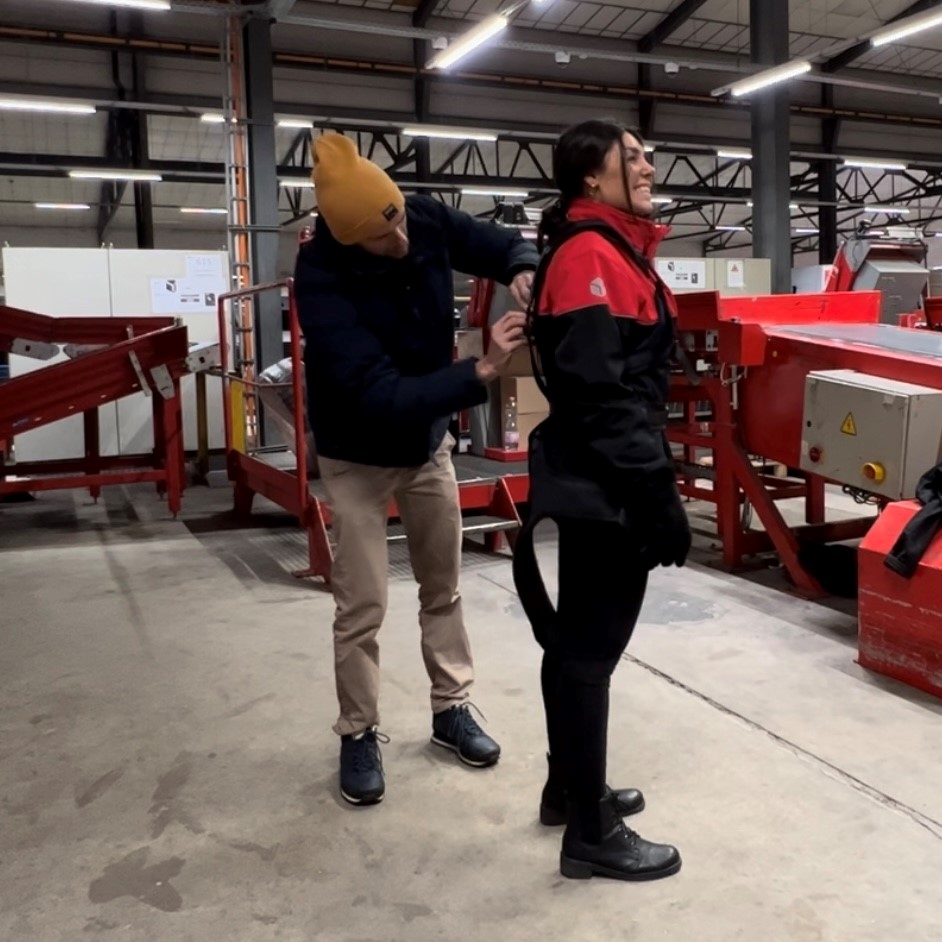Exo… what…?
Do you remember our blog post from March 2022? No worries if you don’t…
This is when we first reported on exoskeletons, and we then also put them to the test in the first blog post in our Beri & Jasmine on tour series. 😊
Here’s a brief recap:
What are exoskeletons?
Exoskeletons are structures worn on the body that can, for example, make heavy lifting easier for our depot employees, saving their strength and their backs. Exoskeletons support the movements of the wearer’s body.
What is the difference between active and passive exoskeletons?
The basic feature of active exoskeletons is primarily the motor or the hydraulics (compressed air). Passive exoskeletons, on the other hand, only support the body by means of mechanical components, such as springs or elastic straps.
Conclusion regarding active exoskeletons:
We used the active exoskeletons with remote control in our depot in Wittenwil for one year. Although carrying heavy tyres, for example, is definitely easier on the back over a whole work shift, it is heavy on the body at around 8 kg. Experience shows that the use of these active exoskeletons makes sense when a usual work shift would consist of really very heavy packages. Ville Heimgarter, our Senior Innovation Project & Sustainability Manager, closely accompanied the test.
DPD: Ville, what’s your feedback from this?
Ville: ‘The response to the active exoskeletons was quite mixed. Specifically, the extra weight was said to feel uncomfortable over longer periods of time. And in the case of lighter parcels, the exoskeleton felt like more of a burden. As a result, it wasn’t used as often as hoped.’
New passive exoskeletons:
We are now extending the test phase of the pilot project and are testing passive exoskeletons. Our test phase began in October 2022 and is expected to run until October 2023. We are currently using them at our depot in Wittenwil, and, in mid-February, we will begin using them in Buchs. Our goal is to continue making the lives of our employees easier and to make our workplace more attractive.
Our new LiftSuit 2 passive exoskeletons are made by Auxivo. Auxivo was founded as a spin-off from Rehabilitation Engineering Lab at ETH Zurich and is based on the expertise and knowledge acquired from many years of research and development.
These passive exoskeletons have elastic elements, also referred to as bands. For example, if you bend down to pick up a load, these elements store energy that is then released during the upward motion. This promotes correct lifting technique and relieves the back and hip muscles. At a weight of <0.9 kg, these exoskeletons are ten times lighter than active exoskeletons, making them one of the lightest on the market. They were developed for use with lighter weights and in particular to ensure good ergonomics.
We ask Ville: why these exoskeletons specifically? Where do you see the benefits?
Ville: ‘Passive exoskeletons are more comfortable to wear thanks to their lighter weight. You can compare them to a winter coat. They are more flexible, lighter and more scalable. All the feedback from the employees has been very positive, and they are worn for significantly longer periods of time. However, digital tracking is not available, and they can only provide around half the support or reduce around half the weight compared to active exoskeletons. However, apart from tyres, we don’t have very many heavy parcels. A typical work shift does not involve all heavy parcels, but rather a mix. More precisely, the average weight of all parcels comes in at around 5 kg. As a result, passive exoskeletons were found to be more comfortable.’
It wouldn’t be Beri & Jasmine on tour if the pair didn’t test them for themselves. 😉 What are the differences? How do passive exoskeletons feel?
Beri: 'Passive exoskeletons are definitely lighter and more comfortable to wear. However, I needed some assistance to tighten the frame. I helped my colleagues in the depot to unload a swap body. My conclusion: I didn’t notice a great deal of difference when standing. However, when I bent down to lift up the parcels, I could feel the elastic bands at the back stretch. So, one thing is that my posture was more ergonomic, while I also felt the bands contract again when I moved back up. This motion did then help my back over longer periods of time.’
Stay tuned! Beri & Jasmine are always heading on tour and will continue to put processes at DPD under the microscope. Bye for now!
Best regards,
Beri & Jasmine



